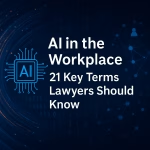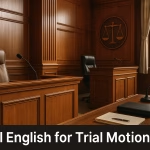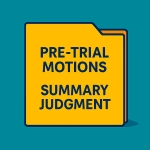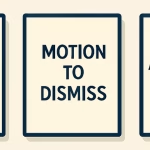Introduction:
Artificial intelligence (AI) is transforming not only how businesses operate but also the language we use to describe work. As The Wall Street Journal recently reported, Walmart’s CEO Doug McMillon has warned that AI will “literally change every job.”
This post breaks down 21 key AI vocabulary terms being used to describe the workplace, with clear explanations and examples to help lawyers, law students, and in-house counsel use them confidently in professional contexts.
Key Vocabulary and Phrases
1. Agent Builder
A brand-new job role where employees design and maintain AI tools, often specializing in creating conversational AI or “agents” for specific business purposes. Walmart recently introduced this position, showing how novel roles are emerging as AI spreads.
Example: “The retailer hired agent builders to create AI solutions for customer service.”
2. Human-in-the-Loop
An AI system design requiring human oversight or intervention to maintain quality, safety, and ethical standards. This model is critical in compliance, liability, and ethical discussions.
Example: “The company adopted a human-in-the-loop model for contract review automation to ensure accuracy.”
3. AI Agents
Chatbots or digital assistants built to interact with customers, employees, or suppliers. They are often designed for a specific purpose, such as handling customer service inquiries or streamlining procurement. Widely used in retail, finance, and law firms.
Example: “The firm deployed AI agents to handle supplier inquiries.”
4. Generative AI (GenAI)
GenAI is a type of artificial intelligence that can create new content such as text, images, or code. By contrast, AI is a broader term, covering all systems that perform tasks requiring human-like intelligence, including automation, prediction, and data analysis.
Example: “While AI helps automate warehouse operations, generative AI (GenAI) is being tested to draft contracts and summarize legal documents.”
5. Lighthouse Project
A high-profile, strategic pilot project used to highlight how AI can transform a specific function, such as research or the supply chain. These projects serve as a proof-of-concept to inspire broader adoption of new technology.
Example: “Syngenta launched a lighthouse project to test AI-driven research methods.”
6. Job Composition Uncertainty
Uncertainty about which jobs will grow, shrink, or vanish as AI spreads. This is a key discussion topic in workforce reports and board meetings.
Example: “Executives admitted there was job composition uncertainty as AI spread.”
7. Workforce Transformation
Major, proactive shifts in the structure and composition of jobs within an organization, often due to AI or automation. It is a strategic process aimed at preparing the workforce for the future.
Example: “The new AI system triggered a workforce transformation across all departments.”
8. Job Redeployment
Reassigning employees to new roles when their old positions are eliminated. This is a key component of a managed workforce transformation and helps reduce layoffs and legal exposure.
Example: “Redeployment helped reduce legal risks during restructuring.”
9. Reskilling / Retraining
Teaching workers new skills to transition into new roles. This is a common practice in corporate compliance and union agreements.
Example: “The employer committed to reskilling its workforce as AI altered job requirements.”
10. Upskilling
Improving existing skills to remain competitive and relevant in an evolving workplace. This is important in continuing legal education and HR initiatives.
Example: “Lawyers must upskill in technology law to advise AI-driven clients.”
11. Exiting Employees
Letting go of workers who cannot be reskilled or redeployed in the AI era. This reflects a strategic workforce decision often mentioned in corporate announcements and HR policies.
Example: “The consulting firm announced it was exiting employees who could not be retrained for AI-driven roles.”
12. Job Elimination
The permanent removal of roles when AI or automation replaces tasks. This is a central concept in layoffs and redundancy policies.
Example: “The company announced job eliminations in its logistics division after introducing AI tools.”
13. Displacement
The loss of employment due to automation or restructuring. It’s a frequent topic in labor law and government policy.
Example: “AI has caused significant worker displacement in logistics.”
14. Head Count
The total number of employees in a company. This is a shorthand term used in HR, contracts, and annual reports.
Example: “Despite automation, Walmart’s head count is expected to remain flat.”
15. Role Composition
The mix of job categories within an organization. This is a core metric in workforce planning and disclosure.
Example: “The company’s role composition shifted as more technical roles emerged.”
16. Automation
Using machines or software to perform tasks previously done by humans. This is a central concept in employment and contract law.
Example: “Warehouse automation has reduced the need for manual labor.”
17. Back-of-Store Tasks
Operational duties performed away from customer view, such as inventory management and sorting, which are often the first to be automated.
Example: “AI now performs many back-of-store tasks like inventory tracking.”
18. Humanoid Robots
Robots designed to resemble humans. While they are a topic of corporate strategy, they are rarely used in customer-facing roles.
Example: “The CEO stressed that humanoid robots won’t replace workers in front-line positions.”
19. Soft Skills
Interpersonal and communication abilities. These are increasingly valued as technical tasks are automated because they are considered difficult to automate.
Example: “Employers now emphasize soft skills like communication and adaptability.”
20. Resilience
The ability to adapt and recover from change. This is seen as a key predictor of long-term workplace success in the face of technological disruption.
Example: “Resilience proved essential during the company’s transition to AI tools.”
21. Job Security
The expectation of stable employment. It is an increasingly uncertain concept in the AI-driven workplace.
Example: “AI adoption has raised concerns about long-term job security.”
Conclusion
AI is transforming not only the workplace but also the vocabulary of work. For lawyers, law students, and in-house counsel, understanding terms like agent builder, human-in-the-loop, and displacement is key to advising clients, drafting contracts, and navigating labor law in the AI era.
Try Personalized Lessons with a Legal English Teacher
At LegalEnglish4Lawyers.com, you can learn with an experienced lawyer and Legal English teacher. Lessons focus on both Legal English and Business English, helping you:
- Master the vocabulary of contracts, negotiations, and compliance
- Build confidence in client meetings, presentations, and emails
Ready to start? Book your personalized lesson today at LegalEnglish4Lawyers.com.
Further Reading
For more on how AI is already reshaping jobs at the world’s largest private employer, see The Wall Street Journal’s coverage of Walmart CEO Doug McMillon’s remarks.
Disclaimer
The content provided herein is only for discussion purposes and may contain errors. The reader is responsible to confirm the accuracy of the information provided. The content does not constitute legal or professional advice. We disclaim any liability for any loss or damage incurred directly or indirectly from the use of this information.
- Legal English for Lawyers: 20 Real Phrases Lawyers Use to Talk About Their Cases
 Introduction: This list of legal English phrases may seem somewhat random — and that’s because it is. These expressions come directly from real conversations with lawyers about their cases, clients, and court proceedings. Each one reflects how legal professionals actually speak in practice, not just how they write. For non-native English-speaking lawyers, learning these authentic… Read more: Legal English for Lawyers: 20 Real Phrases Lawyers Use to Talk About Their Cases
Introduction: This list of legal English phrases may seem somewhat random — and that’s because it is. These expressions come directly from real conversations with lawyers about their cases, clients, and court proceedings. Each one reflects how legal professionals actually speak in practice, not just how they write. For non-native English-speaking lawyers, learning these authentic… Read more: Legal English for Lawyers: 20 Real Phrases Lawyers Use to Talk About Their Cases - How CEOs Are Talking About AI in the Workplace: 21 Key Terms Lawyers Should Know
 Introduction: Artificial intelligence (AI) is transforming not only how businesses operate but also the language we use to describe work. As The Wall Street Journal recently reported, Walmart’s CEO Doug McMillon has warned that AI will “literally change every job.” This post breaks down 21 key AI vocabulary terms being used to describe the workplace,… Read more: How CEOs Are Talking About AI in the Workplace: 21 Key Terms Lawyers Should Know
Introduction: Artificial intelligence (AI) is transforming not only how businesses operate but also the language we use to describe work. As The Wall Street Journal recently reported, Walmart’s CEO Doug McMillon has warned that AI will “literally change every job.” This post breaks down 21 key AI vocabulary terms being used to describe the workplace,… Read more: How CEOs Are Talking About AI in the Workplace: 21 Key Terms Lawyers Should Know - 27 Useful English Expressions for Lawyers in the Workplace
 Strengthen Your Communication Inside and Outside the Office with 27 Useful English Expressions for Lawyers in the Workplace Introduction For lawyers — especially those working with business teams or serving as in-house counsel — mastering everyday business English phrases is just as important as understanding legal terms. These expressions often appear in emails, meetings, and… Read more: 27 Useful English Expressions for Lawyers in the Workplace
Strengthen Your Communication Inside and Outside the Office with 27 Useful English Expressions for Lawyers in the Workplace Introduction For lawyers — especially those working with business teams or serving as in-house counsel — mastering everyday business English phrases is just as important as understanding legal terms. These expressions often appear in emails, meetings, and… Read more: 27 Useful English Expressions for Lawyers in the Workplace - Reduce Stress After Work With the Powerful Technique of One-Pointedness (Ekāgratā)
 Reduce stress, restore calm, and gain clarity after a busy day with one-pointedness (ekāgratā) as described in Patanjali’s Yoga Sutras. 1. Key Takeaway Practicing ekāgratā — one-pointed focus on a single object like breath, music, or a hobby — helps calm the mind, reduce stress, and restore clarity. Just a few minutes a day can… Read more: Reduce Stress After Work With the Powerful Technique of One-Pointedness (Ekāgratā)
Reduce stress, restore calm, and gain clarity after a busy day with one-pointedness (ekāgratā) as described in Patanjali’s Yoga Sutras. 1. Key Takeaway Practicing ekāgratā — one-pointed focus on a single object like breath, music, or a hobby — helps calm the mind, reduce stress, and restore clarity. Just a few minutes a day can… Read more: Reduce Stress After Work With the Powerful Technique of One-Pointedness (Ekāgratā) - Mastering Legal English: 8 Strategies for Non-Native English-Speaking Lawyers and Law Students
 Introduction. For lawyers and law students who speak English as a second language, developing fluency in Legal English is essential for success in today’s global legal environment. Whether you’re advising clients, negotiating agreements, preparing legal documents, or appearing in court, the ability to express yourself clearly, professionally, and persuasively in English can significantly affect your… Read more: Mastering Legal English: 8 Strategies for Non-Native English-Speaking Lawyers and Law Students
Introduction. For lawyers and law students who speak English as a second language, developing fluency in Legal English is essential for success in today’s global legal environment. Whether you’re advising clients, negotiating agreements, preparing legal documents, or appearing in court, the ability to express yourself clearly, professionally, and persuasively in English can significantly affect your… Read more: Mastering Legal English: 8 Strategies for Non-Native English-Speaking Lawyers and Law Students - Legal English Phrasal Verbs – Part 2: 10 More Key Expressions Every Lawyer Must Know
 Introduction. Legal professionals use phrasal verbs every day—often without even realizing it. Whether you’re drafting documents or negotiating terms, understanding these expressions can improve your fluency and confidence. Here are 10 more essential Legal English phrasal verbs to add to your toolkit. 10 More Phrasal Verbs Every Lawyer Should Know: 1. Carry out Definition: To… Read more: Legal English Phrasal Verbs – Part 2: 10 More Key Expressions Every Lawyer Must Know
Introduction. Legal professionals use phrasal verbs every day—often without even realizing it. Whether you’re drafting documents or negotiating terms, understanding these expressions can improve your fluency and confidence. Here are 10 more essential Legal English phrasal verbs to add to your toolkit. 10 More Phrasal Verbs Every Lawyer Should Know: 1. Carry out Definition: To… Read more: Legal English Phrasal Verbs – Part 2: 10 More Key Expressions Every Lawyer Must Know - Appeals and Enforcement – 8 Key Legal English Vocabulary Words – Litigation Vocabulary Series – Part 8
 Introduction To Legal English for Appeals and Enforcement. The litigation process doesn’t always end with judgment. For many clients, the most critical work begins with an appeal or the challenge of enforcing a judgment. This final stage requires a new set of Legal English skills—focused on persuasive writing, procedural accuracy, and strategic enforcement tools. In… Read more: Appeals and Enforcement – 8 Key Legal English Vocabulary Words – Litigation Vocabulary Series – Part 8
Introduction To Legal English for Appeals and Enforcement. The litigation process doesn’t always end with judgment. For many clients, the most critical work begins with an appeal or the challenge of enforcing a judgment. This final stage requires a new set of Legal English skills—focused on persuasive writing, procedural accuracy, and strategic enforcement tools. In… Read more: Appeals and Enforcement – 8 Key Legal English Vocabulary Words – Litigation Vocabulary Series – Part 8 - Judgment and Remedies: 8 Key Legal English Words – Legal English Litigation Vocabulary Series – Part 7
 Introduction To Judgment & Remedies. When a trial concludes, the court enters its decision—and the consequences become real. Whether seeking financial compensation, injunctive relief, or a final declaration of rights, attorneys must be fluent in the specialized Legal English used to discuss judgment and remedies. This post—Part 7 in our 8-part Litigation Vocabulary Series—offers essential… Read more: Judgment and Remedies: 8 Key Legal English Words – Legal English Litigation Vocabulary Series – Part 7
Introduction To Judgment & Remedies. When a trial concludes, the court enters its decision—and the consequences become real. Whether seeking financial compensation, injunctive relief, or a final declaration of rights, attorneys must be fluent in the specialized Legal English used to discuss judgment and remedies. This post—Part 7 in our 8-part Litigation Vocabulary Series—offers essential… Read more: Judgment and Remedies: 8 Key Legal English Words – Legal English Litigation Vocabulary Series – Part 7 - The Trial Stage Legal English Vocabulary – 8 Essential Litigation Vocabulary Terms- Part 6
 Introduction To The Trial Stage. The trial is the culmination of months—or years—of litigation strategy. At this stage, clarity in courtroom communication is paramount. Whether addressing the judge, persuading a jury, or objecting to testimony, precise use of Legal English vocabulary for trial can influence the outcome. This sixth entry in our Litigation Vocabulary Series… Read more: The Trial Stage Legal English Vocabulary – 8 Essential Litigation Vocabulary Terms- Part 6
Introduction To The Trial Stage. The trial is the culmination of months—or years—of litigation strategy. At this stage, clarity in courtroom communication is paramount. Whether addressing the judge, persuading a jury, or objecting to testimony, precise use of Legal English vocabulary for trial can influence the outcome. This sixth entry in our Litigation Vocabulary Series… Read more: The Trial Stage Legal English Vocabulary – 8 Essential Litigation Vocabulary Terms- Part 6 - Pre-Trial Motions and Summary Judgment-Essential Litigation Vocabulary-Part 5
 Introduction To Pre-Trial Motions and Summary Judgment. As litigation approaches trial, pre-trial motions become a central strategic tool. This phase is about shaping what the judge or jury will hear, what evidence will be admitted, and even whether a trial is necessary at all. For attorneys—especially those working internationally or in a second language—fluency in… Read more: Pre-Trial Motions and Summary Judgment-Essential Litigation Vocabulary-Part 5
Introduction To Pre-Trial Motions and Summary Judgment. As litigation approaches trial, pre-trial motions become a central strategic tool. This phase is about shaping what the judge or jury will hear, what evidence will be admitted, and even whether a trial is necessary at all. For attorneys—especially those working internationally or in a second language—fluency in… Read more: Pre-Trial Motions and Summary Judgment-Essential Litigation Vocabulary-Part 5 - Discovery Phase-Essential Litigation Vocabulary-Part 4
 Introduction To The Discovery Phase. The discovery phase is often the longest and most complex part of litigation. It is the stage where both parties exchange information, investigate facts, and gather evidence that will shape their legal strategies. Mastery of the litigation vocabulary language used during discovery is critical—not only to comply with procedural rules… Read more: Discovery Phase-Essential Litigation Vocabulary-Part 4
Introduction To The Discovery Phase. The discovery phase is often the longest and most complex part of litigation. It is the stage where both parties exchange information, investigate facts, and gather evidence that will shape their legal strategies. Mastery of the litigation vocabulary language used during discovery is critical—not only to comply with procedural rules… Read more: Discovery Phase-Essential Litigation Vocabulary-Part 4 - Defenses & Responsive Pleadings-Essential Litigation Vocabulary-Part 3
 Introduction: Defenses & Responsive Pleadings After a lawsuit is filed, the defendant’s response becomes the first major pivot point in the litigation. This stage introduces critical tools that may limit, delay, or even extinguish the plaintiff’s claims—before the case reaches discovery or trial. Lawyers must not only understand the procedures but also command the litigation… Read more: Defenses & Responsive Pleadings-Essential Litigation Vocabulary-Part 3
Introduction: Defenses & Responsive Pleadings After a lawsuit is filed, the defendant’s response becomes the first major pivot point in the litigation. This stage introduces critical tools that may limit, delay, or even extinguish the plaintiff’s claims—before the case reaches discovery or trial. Lawyers must not only understand the procedures but also command the litigation… Read more: Defenses & Responsive Pleadings-Essential Litigation Vocabulary-Part 3 - Filing a Lawsuit-Essential Litigation Vocabulary-Part 2
 Introduction Filing a lawsuit formally initiates a legal dispute and sets in motion the procedural and substantive mechanisms of civil litigation. For lawyers—especially international attorneys practicing or transacting with U.S. clients—mastery of the legal English litigation vocabulary used at this stage is essential. Drafting a complaint, evaluating jurisdiction, and ensuring service are not mere formalities;… Read more: Filing a Lawsuit-Essential Litigation Vocabulary-Part 2
Introduction Filing a lawsuit formally initiates a legal dispute and sets in motion the procedural and substantive mechanisms of civil litigation. For lawyers—especially international attorneys practicing or transacting with U.S. clients—mastery of the legal English litigation vocabulary used at this stage is essential. Drafting a complaint, evaluating jurisdiction, and ensuring service are not mere formalities;… Read more: Filing a Lawsuit-Essential Litigation Vocabulary-Part 2 - Pre-Litigation Stage-Essential Litigation Vocabulary-Part 1
 Introduction Litigation doesn’t begin in the courtroom—it often starts long before a complaint is filed. The pre-litigation stage is a critical phase in which lawyers communicate through letters, notices, and negotiations to resolve disputes or lay the groundwork for formal legal action. For lawyers and law students working in international or cross-border matters, mastering the… Read more: Pre-Litigation Stage-Essential Litigation Vocabulary-Part 1
Introduction Litigation doesn’t begin in the courtroom—it often starts long before a complaint is filed. The pre-litigation stage is a critical phase in which lawyers communicate through letters, notices, and negotiations to resolve disputes or lay the groundwork for formal legal action. For lawyers and law students working in international or cross-border matters, mastering the… Read more: Pre-Litigation Stage-Essential Litigation Vocabulary-Part 1 - 10 Legal English Terms Every International Lawyer Should KnowWhether you’re drafting a contract, negotiating a deal, or advising clients across borders, here are 10 essential Legal English terms you should know—and know how to use correctly. 1. Indemnify To compensate for harm or loss. Often used in contract clauses related to liability. Example: “The supplier shall indemnify the buyer against all claims arising… Read more: 10 Legal English Terms Every International Lawyer Should Know